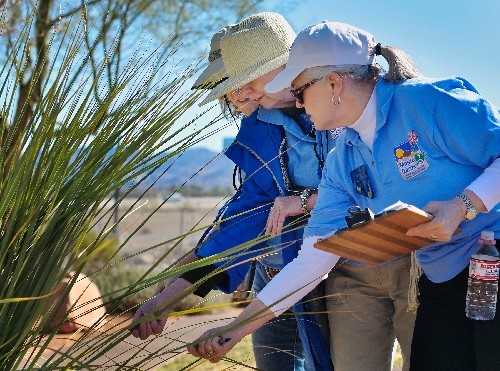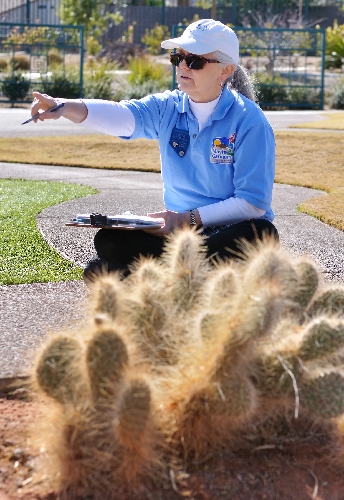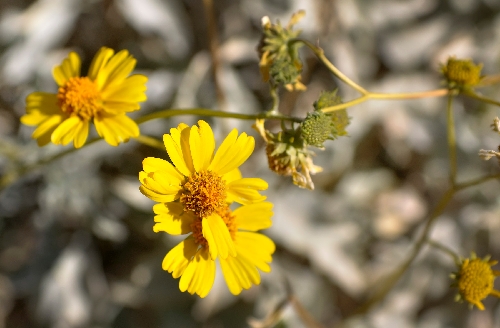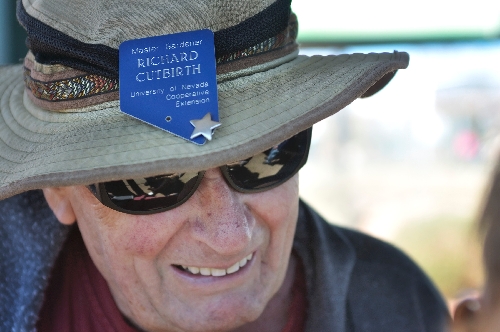Master Gardeners teaching desert dwellers how to make their gardens grow
Linn Mills started the Master Gardener program in Southern Nevada almost in self-defense.
In 1992, Mills -- now a horticulturist for the Las Vegas Valley Water District at the Springs Preserve -- was the southern area director for University of Nevada Cooperative Extension. And all of a sudden, the extension's horticulturists needed help.
"Ours was just a little town," Mills recalls. "We were able to take care of it. Then all of a sudden, everything just proliferated."
He'd heard about Master Gardeners, a national initiative that started in the Seattle area.
"The only way we could go out and reach people," he said, "was through the Master Gardener program."
In the 20 years since Mills asked for help, the Southern Nevada program has certified more than 1,000 people as Master Gardeners, with 300 of them still active. Their 273,827 volunteer hours have been estimated at a value of more than $5 million over the years. And they'll celebrate their anniversary with a Garden Gala community open house April 21.
To become a Master Gardener, a person must take 80 hours of instruction, at which point they're considered an intern; the Master Gardener designation comes after a minimum of 50 hours of volunteering. Once they achieve official status, they must commit to at least 50 hours of volunteering a year to maintain it.
"It is a big commitment," says Ann Edmunds, program coordinator. "That's one of the things I think is most incredible about Master Gardeners -- they take intensive training and volunteer at least 50 hours, but the average is more like 120. They're out there. They want to be out there."
That certainly was the case for Jean Toscano, a Master Gardener who's chairwoman for class instruction at Acacia Park in Henderson. Toscano says she tried to get into the training sessions for four years, but every time she called, the classes -- which can accommodate 50 students in the spring, 50 in the fall -- were full.
"So I was elated when I got in in 2008," Toscano says.
She moved to the valley from Wyoming, and says she initially was interested simply in learning about gardening in the desert. Of her current involvement, she says, "I guess I got excited. I went through the program and I thought, 'Oh, if people only knew this, they'd have gorgeous yards and be able to have produce from those yards and be able to support themselves a little better.' "
Acacia Park, she says, serves as a desert demonstration garden, and that status is the source of the most common question she hears.
"A lot of times, people believe that the stuff that's grown there is treated differently than they would need to treat it in their yard," Toscano says. "The biggest question is 'Would that really grow in my yard?' "
The answer: Yes, assuming you use the right soil, right care, right place in the yard.
"There are a lot of cool things that you can plant," Toscano says.
Edmunds, who's been coordinator for more than six years, says, "We're actually a great gardening mecca here. The Las Vegas program is probably one of the most intensive and extensive programs," whose 80 hours of training compares with 40 or 45 in other states. "We do have the population and we have the interest in gardening and we actually have a wonderful climate for gardening if you know how to do it in the desert."
Which is not, she acknowledges, without its challenges, which include alkaline soils, "4 inches of rain -- if that -- per year," hot, drying winds and temperatures that can range from 20 degrees in the winter to 120 degrees in the summer.
"If you know how to grow things, you can have wonderful landscapes, you can have wonderful fruits and vegetables," she says. "That's what we teach."
And they do it in dozens of locations across Southern Nevada. They help out with community gardens, a lot of them at senior centers, Edmunds says. They work with personnel at Nellis Air Force Base, showing them how to prune desert trees. They man information tables at community events, including "green fairs" at local casinos.
"People want to know how to grow landscape plants, tomatoes, how come their lawn's dying or why their water bill is so high," she says.
They assist with the Doolittle Community Garden for the city of Las Vegas. The people who participate in the community garden "not only eat the food but they take it to a food bank," Mills says. "I think that's been one of the most successful of them all."
"Any place where we can reach the public, that's where we are," Edmunds says.
They also man an information line -- 257-5555 -- from 8 a.m. to 5 p.m. weekdays. Those answering the line, Edmunds says, respond to questions -- 4,029 by phone and email last year -- and are trained in how to research what they don't know.
"It's unbiased advice," she says. "They're not promoting a product."
Mills says that phone line was a bit of a problem in the early days.
"What I think is the beauty of the program," he says, "is it all began with 'you take training and then you answer phones for 50 hours' " a year. "Nobody liked the phones."
The attrition rate was high, Mills says. Of the 50 people who completed the classes, maybe five or 10 would be left after a year.
"Then we hired a Master Gardener coordinator," he says. "All of a sudden they could do other things. Now you're going out and teaching classes, doing community gardens. The university uses them extensively" at the Lifelong Learning Center at 8050 Paradise Road. "They put in a flower bed, they maintain it, they give classes, guided tours."
Last year, they taught or spoke to more than 45,000 people at events in the community.
Edmunds says the Master Gardeners come from all walks of life.
"We have one Master Gardener who just graduated from high school," she says. "And then there are mothers with kids, retired people -- retired stockbrokers, dentists, plumbers, electricians, Air Force people. It's everybody.
"It's open to people who are interested in gardening, but more importantly, who are people interested in sharing what they've learned with other people and in working on our community projects."
Many of them, she says, are reflective of Southern Nevada's general population in that they come from somewhere else.
"They want to garden here, and gardening here is so different from anyplace else," Edmunds says. "Here, you forget to water it, you don't give it nutrients, it's not going to do as well.
"We're not the one saying, 'I want to grow the biggest and best tomato,' " she says. "We're teachers, instructors, we want to share with the public how to make their yards as energy-efficient and as pretty as possible within the parameters of living here in the desert."
"I'm guessing most people come to gardening like I did, which is trial and error," Toscano says. "You get tired of watching something you put in with such excitement die."
Mills says, "It's become an ideal program because you have a lot of people who are really interested in gardening. So everybody benefits from everybody.
"It's one of those government programs that has a good benefit."
Contact reporter Heidi Knapp Rinella at hrinella@reviewjournal.com or 702-383-0474.
Take a Tour
Landscape tours have been scheduled for Saturday mornings this spring at the Demonstration Gardens on the campus of the University of Nevada Cooperative Extension at 8050 Paradise Road, near the Las Vegas Beltway and Windmill Lane. Tours, which will meet in the courtyard at the Lifelong Living Center, begin at 10 a.m. March 24 and April 14.
The Master Gardeners will celebrate their 20th anniversary with the Garden Gala -- with garden tours, talks and demonstrations -- from 10 a.m. to 4 p.m. April 21.
For details, call the help line at 257-5555. For more information on the Master Gardener program, call Ann Edmunds at 257-5587 or email edmundsa @unce.unr.edu.

























